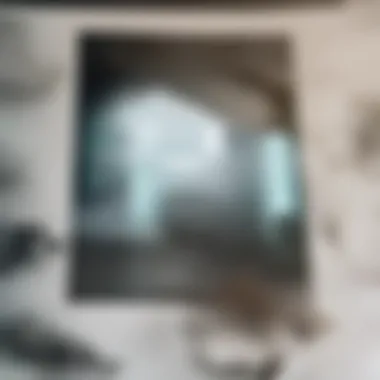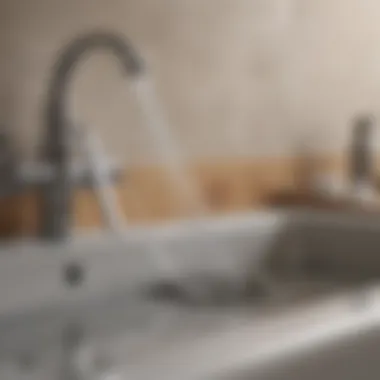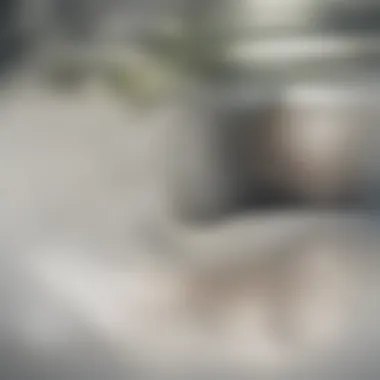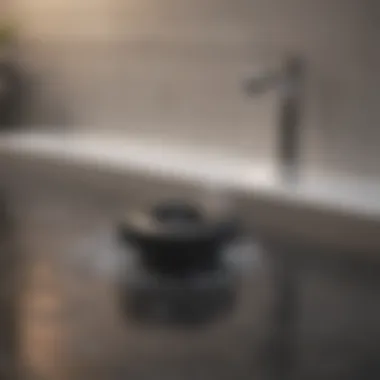Effective Techniques for Clearing Hair from Tub Drains


Intro
Hair build-up in tub drains is a common issue that many homeowners encounter. It causes inconvenience and can lead to larger plumbing problems if left unattended. Understanding how hair accumulates in drains helps in devising effective strategies for clearance and prevention.
In this article, we will discuss both traditional and modern techniques for clearing hair from tub drains. Knowing the causes of hair clogs is crucial so that one can address them effectively.
We will also highlight preventive measures that help maintain efficient drainage in bathrooms. With this comprehensive guide, you will gain valuable insights to keep your tub drains functional and your plumbing system healthy.
Understanding the Problem
Clearing hair from tub drains is not simply a matter of aesthetics; it is a critical aspect of home maintenance that affects plumbing efficiency and hygiene. When tub drains become clogged with hair, it can lead to slow drainage or even complete blockages. Understanding this problem is the first step in maintaining a functional and clean bathroom.
Common Causes of Clogged Tub Drains
Clogged tub drains primarily result from the accumulation of hair, combined with soap scum and other debris. Factors contributing to this issue include:
- Hair shedding: Human hair naturally sheds during washing or bathing. Over time, this accumulation can build up and create clogs.
- Soap buildup: Many soaps and shampoos contain fats and oils that can combine with hair and other materials, forming a solid mass in the drain.
- Calcium deposits: Hard water can lead to mineral deposits that adhere to hair and other substances, further complicating drainage.
Each of these causes can interact to exacerbate the problem, making it imperative to address them effectively.
Impact of Hair Buildup on Drainage
The presence of hair buildup has a direct impact on drainage efficiency. As hair collects in the drain, it creates a barrier that inhibits water flow. Consequently, homeowners may experience:
- Reduced water drainage speed: Slow draining can become more pronounced, causing frustration during daily routines.
- Unpleasant odors: Stagnant water can lead to the growth of mold or bacteria, which may produce foul smells.
- Potential damage: Severe clogs can result in backups, which might lead to costly plumbing repairs or water damage.
Why Hair Accumulates in Tub Drains
The accumulation of hair in tub drains occurs primarily due to bathing habits and grooming practices. Factors influencing this include:
- Frequency of use: Higher usage often leads to more substantial hair accumulation. Households with multiple family members are particularly prone to this issue.
- Hair type and length: Longer hair is more likely to entangle and snag within plumbing fixtures, exacerbating clogs.
- Lack of preventive measures: Without using drain covers or regularly maintaining drains, hair can easily build up with time.
By comprehending these elements, homeowners can take proactive steps to mitigate hair accumulation and maintain efficient plumbing.
Preventive Measures
Preventing hair clogs in tub drains is essential to avoid costly repairs and maintain a functional bathroom. By implementing effective preventive measures, homeowners can significantly reduce the risk of hair buildup. This proactive approach saves time, effort, and money in the long run.
Installation of Drain Screens
Installing drain screens is one of the simplest yet most effective methods to block hair from entering the drain. These screens can capture hair, soap scum, and other debris that might otherwise contribute to clogs. They come in various types, such as mesh or solid, and are available in most hardware stores.
Benefits of Drain Screens:
- Cost-Effective: Affordable and easy to install.
- Maintenance Ease: Simple to clean regularly to ensure full functionality.
- Versatile: Suitable for various types of drains.
Many homeowners overlook this essential step. Choosing the right size and shape screen is vital. A well-fitted screen effectively prevents hair from escaping into the plumbing system, ultimately extending the lifespan of the pipes.
Regular Maintenance Practices
Regular maintenance of your tub drain is crucial for optimal performance. Routine cleaning tasks can help identify potential issues early before they develop into severe problems. A few practices include:
- Weekly Cleaning: Use a mixture of baking soda and vinegar to break down buildup.
- Monthly Inspections: Check for any visible hair or debris that could lead to blockages.
- Clear Drains After Use: Ensure that hair is removed immediately after bathing.
Engaging in these practices cultivates a habit of care that will keep drains flowing freely. When problems are spotted early, they are easier to correct.
Adopting Proper Washing Techniques


How you wash your hair and body can influence the amount of hair that ends up in the drain. Adopting a few simple changes in technique can greatly reduce the hair loss in the tub. Consider the following tips:
- Rinse Hair Outside the Tub: If possible, rinse your hair in a sink instead of the tub.
- Use Conditioner Sparingly: Reducing conditioner will limit hair shedding during washing.
- Brush Hair Before Bathing: This practice can help remove loose hair before it can enter the drain.
Being mindful of these washing techniques can save homeowners from future plumbing hassles. Small adjustments in routine can make a significant difference in reducing hair debris in the drains.
Tools and Materials Required
When it comes to clearing hair from tub drains, having the right tools and materials is essential. Proper equipment not only makes the task easier but also increases efficiency and effectiveness. Understanding the requirements at this stage can save time and effort later on. It can also prevent costly damages associated with improper methods.
Essential Tools for Cleaning
To clear hair from your tub drains, several essential tools should be on hand:
- Plunger: This basic tool can dislodge minor clogs caused by hair and soap buildup.
- Drain Snake: A flexible tool that can reach into the drain and remove hair clogs.
- Gloves: Protects your hands while cleaning.
- Bucket: Place it under the drain to collect any debris that may fall out during the process.
- Screwdriver: Helpful for removing the drain cover if necessary.
- Wet-Dry Vacuum: A powerful tool capable of sucking up hair and debris from the drain.
Each of these tools serves a unique function, facilitating a smoother clearing process. Having these tools ready can simplify the task and make it more manageable.
Biodegradable Cleaners vs. Chemical Solutions
The choice between biodegradable cleaners and chemical solutions is an important consideration. Biodegradable cleaners are often gentler on both plumbing and the environment. They typically use natural ingredients that break down without harming aquatic life. However, they may require more time to work compared to harsher chemicals.
In contrast, chemical solutions can offer immediate results for stubborn clogs. Yet, these can be harmful to pipes over time and may pose safety risks to users, including skin irritation and respiratory issues. It is advisable to read labels carefully and follow instructions provided by manufacturers. The selection depends largely on individual needs and preferences. Many may find that a combination of both types yields the best results.
Utilizing Household Items
Some household items can be incredibly useful in clearing hair from tub drains. Common items include:
- Baking Soda and Vinegar: A classic combination that can break down clogs naturally.
- Dish Soap: It can help lubricate hair clogs, allowing them to slide down the drain easier.
- Hot Water: Pouring hot water can dissolve soap and grease buildup that may accompany hair.
Using what is available at home not only saves money but also emphasizes a do-it-yourself approach. These solutions are typically safe and easy to implement, making them great options for those looking to avoid commercial products.
"Being prepared with the right tools and materials can make all the difference when clearing hair from tub drains. Simple preparations lead to effective solutions."
Step-by-Step Clearing Techniques
Understanding the step-by-step clearing techniques is essential for effectively addressing hair-related drain issues. These methods provide homeowners with practical solutions to maintain functionality in their plumbing systems. Following a structured approach helps to minimize frustration and can often avoid the need for professional services.
Each technique focuses on a specific tool or method, presenting both the process and the benefits associated with each choice. By learning these techniques, individuals can develop confidence in handling common plumbing issues. An effective clearing technique not only removes clogs but also contributes to the overall hygiene of the bathroom and can prolong the life of plumbing fixtures.
Manually Removing Hair: The Basics
Manual removal of hair is a straightforward technique. Start by using a pair of gloves to protect your hands.
To begin:
- Remove the drain cover: Depending on the type of cover, a flathead screwdriver may be needed to unscrew it.
- Use your fingers to reach for the hair: Carefully pull out visible strands without pushing them further down the pipe.
- Utilize a wire hanger: Straightening a wire hanger can assist in grabbing hair stuck deeper in the drain.To do this, make a hook at the end and slowly push it into the drain.
This basic technique can be quite effective for minor clogs, but it is important to know when to move on to more advanced methods if obstruction persists.
Using a Drain Snake
The drain snake, or plumber's auger, is a powerful tool for tackling more stubborn hair clogs. It consists of a long, flexible cable with a coiled tip.
Here’s how to use it:
- Insert the snake into the drain: Push it gently through the opening until you feel resistance.
- Rotate the handle: Turning the snake allows the coils to grab hair and other debris.
- Pull back the snake: Remove it carefully, along with the captured hair. Repeat the process if necessary.


This technique is efficient for hair that is lodged deeper in the plumbing and can clear clogs without harsh chemicals.
Applying a Plumber’s Helper
A plumber's helper, commonly known as a plunger, can also be useful for clearing hair clogging the tub drain. It generates suction to dislodge blockages effectively.
To use a plumber’s helper:
- Remove any standing water: This allows for better suction.
- Place the plunger over the drain: Ensure it forms a tight seal around the drain opening.
- Press and pull: Rapidly thrust the plunger up and down to create suction, which can dislodge hair clogs.
This method may require several attempts depending on the severity of the clog but is generally safe and non-invasive.
Employing a Wet-Dry Vacuum
Using a wet-dry vacuum can be an effective way to tackle significant hair blockages. This method works by creating suction to remove stuck hair.
Steps to follow:
- Set the vacuum to liquids: Ensure the vacuum is configured to handle wet materials.
- Create a seal: Position the vacuum hose over the drain to avoid any air leaks.
- Turn on the vacuum: Let it run for a few seconds to draw hair out.
This technique can yield good results for larger blockages, particularly when other methods fail.
By mastering these techniques, homeowners can maintain effective drainage systems and alleviate potential plumbing issues caused by hair accumulation.
Chemical Solutions for Clogs
When dealing with hair-clogged tub drains, chemical solutions can be particularly effective. They offer a different approach compared to manual methods. Chemical cleaners dissolve hair and buildup, cleaning your drains more efficiently. Knowing when and how to use these substances can help maintain your plumbing. It is important to weigh both the benefits and the risks associated with these products.
When to Use Chemical Cleaners
Chemical cleaners are best used when a clog is severe and traditional methods, such as manual removal or drain snakes, have been unsuccessful. During heavy rainfall, increased water flow can cause clogs to worsen. Additionally, using a chemical cleaner may be wise if you notice slow drainage over a period of time. They can prevent minor issues from escalating into more significant blockages. Evaluate the situation carefully to determine if chemical cleaners are the best method for your specific plumbing problem.
Safety Precautions
Using chemical cleaners requires precautions to ensure safety. These products often contain harsh ingredients which can harm both your health and plumbing fixtures. Here are several essential safety measures:
- Wear Gloves: Protect your skin from irritation caused by chemical exposure.
- Use Eye Protection: Splashing chemicals can injure your eyes.
- Proper Ventilation: Ensure your work area is well-ventilated. Fumes can be harmful.
- Follow Instructions: Adhere closely to the instructions on the label for safe and effective use.
Keep children and pets away from the work area until you are confident it is safe. Being cautious can prevent accidents in your home.
Alternative Cleaning Agents
If you prefer a more natural approach or are concerned about chemical cleaners, several alternative cleaning agents are available. These can be effective in dissolving hair and buildup without the harsh effects of chemicals. Consider using:
- Baking Soda and Vinegar: This combination reacts to help break down clogs. Pour baking soda down the drain followed by vinegar. Seal and wait for about 30 minutes before flushing with hot water.
- Salt and Boiling Water: Pour salt down the drain, followed by boiling water. This method helps to dislodge debris.
- Biodegradable Enzymatic Cleaners: These cleaners utilize enzymes to break down organic material over time. They are effective and less harmful to the environment.
Addressing Severe Clogs
Addressing severe clogs is an essential part of maintaining the functionality of your tub drains. Ignoring this aspect could lead to more serious plumbing issues over time. Severe clogs often result from a combination of hair accumulation and other debris that can cause water to back up. Resolving these clogs prevents potential water damage and saves money on repair costs down the line.
Identifying Severely Blocked Drains
The first step in addressing severe clogs is identifying the issue early. If you notice water not draining quickly or standing water in your tub, it is likely time to investigate. Severe blockages can manifest through:
- Foul odors coming from the drain
- Unusual gurgling sounds when running water
- Water rising in other fixtures when using the tub
If you observe any of these signs, it's vital to take action. Using a flashlight, inspect the drain to see if you can spot any visible hair or debris. If the obstruction is not accessible, it may require more involved cleaning techniques.


Calling Professional Help: When and Why
Sometimes, despite your best efforts, the clog may prove tougher than anticipated. This is when calling a professional can be crucial. It’s wise to seek assistance if:
- You are unable to locate the blockage
- Your clearing attempts are unsuccessful
- Water is leaking or pooling in unintended areas
Professionals have specialized tools and knowledge that can resolve severe clogs efficiently. They can also spot underlying issues that might not be apparent, such as broken pipes or extensive buildup that could lead to more significant problems.
Cost Implications of Professional Services
The cost of hiring a plumbing professional can vary widely based on location and the complexity of the job. Typical expenses can range from $100 to $500. This cost includes:
- Initial service call rates
- Time taken to clear the clog
- Any additional repairs if needed
Weighing these costs against potential damage to your plumbing system can highlight the importance of early intervention. Investing in professional help can save you more significant expenses in the future.
"Early recognition and swift action can be your best allies against severe clogs."
Post-Clearing Maintenance
Post-clearing maintenance is a crucial aspect of maintaining tub drains after addressing hair blockages. Once the drains are cleared, the risk of future clogs remains significant without a proper maintenance strategy. Routine care not only prolongs the efficiency of your plumbing but also reduces the likelihood of larger problems arising in the future.
Effective post-clearing maintenance involves adopting a proactive approach. It ensures that debris, particularly hair, does not accumulate again in your tub drain. This stage makes it important to recognize and establish a maintenance schedule that fits your household's needs.
Implementing a Maintenance Schedule
Creating a maintenance schedule is pivotal in preventing hair buildup in tub drains. Regular intervals of cleaning and inspection can drastically decrease the chances of clogs. Here are some steps to consider when establishing this schedule:
- Weekly Check: At least once a week, inspect the drain for any visible signs of buildup. This can be as simple as removing a drain cover to look for hair or other debris.
- Monthly Cleaning: Set aside time each month for cleaning methods to clear any minor blockages that may have accumulated. This could involve using a drain snake or a wet-dry vacuum.
- Seasonal Maintenance: Every three to six months, conduct a more thorough inspection including checking the pipes leading away from the tub. You might want to consider hiring a professional every few years to thoroughly clean the plumbing system.
In following a consistent maintenance schedule, homeowners can greatly reduce the impacts of hair accumulation over time.
Signs of Recurring Problems
Being able to identify signs of recurring problems is just as important as maintaining a schedule. Early detection of issues can prevent more extensive damage and costly repairs. Here are key indicators that your tub drain might be facing recurring blockages:
- Slow Drainage: If water takes longer than normal to drain, this is often the first sign of hair or other material accumulating in the pipes.
- Unpleasant Odors: Foul smells emanating from the drain can indicate decaying organic material that may lead to severe clogs.
- Gurgling Noises: Sounds coming from the drain while the water flows can signal air trapped in the pipes, often a precursor to complete blockage.
Homeowners should not overlook these signals. Addressing these promptly can help maintain the functionality of tub drains and avoid prolonged inconvenience.
Regular maintenance nurtures not only the health of your plumbing but also your peace of mind.
By actively engaging in post-clearing maintenance and being vigilant for signs of trouble, homeowners can ensure smoother drainage and extend the lifespan of their plumbing systems.
Ending
Understanding how to effectively clear hair from tub drains is crucial for maintaining proper plumbing function. This article has covered various aspects of hair buildup, including common causes, techniques for removal, and preventive tools available to homeowners. Hair can cause significant disruptions in drainage, leading to more severe plumbing problems, which can result in costly repairs and inconveniences. Therefore, recognizing the issue early and taking proactive measures is necessary to preserve the integrity of the plumbing system.
"Regular maintenance is key to avoiding costly drainage issues in the future."
In this guide, we emphasized tools and methods such as drain snakes, wet-dry vacuums, and both chemical and non-chemical solutions. Homeowners now have a comprehensive toolkit to tackle minor clogs and know when to seek professional help for severe issues.
Lastly, the significance of consistent post-clearing maintenance cannot be overstated. Developing a routine for drain care while actively checking for signs of recurring problems will significantly aid in prolonging the life of your drains, ultimately saving money and maintaining a smoothly functioning home environment.
Summary of Key Points
- Common Causes of Clogs: Hair is a primary factor in tub drain blockages.
- Preventive Measures: Using drain screens and establishing a regular maintenance routine help minimize buildup.
- Cleaning Techniques: Both manual and tool-assisted methods are effective for clearing hair.
- Chemical Solutions: Use these sparingly and with consideration to safety precautions.
- Professional Help: Recognizing when to call a plumber is important to address severe clogs.
- Post-Clearing Care: Regular maintenance is essential for preventing future problems.
Recommendations for Homeowners
- Install Drain Covers: Prevent hair from going down the drain by using effective trap systems.
- Regular Cleaning: Establish a monthly cleaning schedule to minimize hair accumulation in tub drains.
- Proper Techniques: Educate yourself and family on how to wash hair without causing clogs.
- Know Your Tools: Familiarize with tools like drain snakes and wet-dry vacuums for home use.
- Monitor Drain Behavior: Regularly check for slow drainage or unusual sounds, as these may indicate buildup.
- Consult Professionals When Needed: Don't hesitate to call a plumber for persistent or severe drainage issues.
By following these recommendations, homeowners can maintain efficient plumbing systems and prevent the frustration that often accompanies clogged tub drains.







